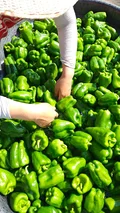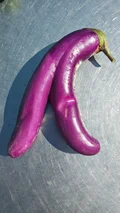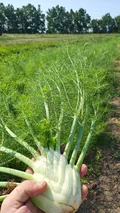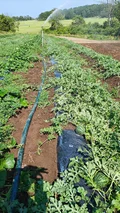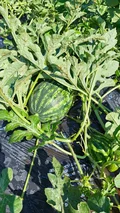TL;DR
On a 95 degree day, we moved pigs, harvested chard, peppers, eggplant and fennel all before noon. In the afternoon, cool-down activities involved potting on seedlings, washing eggs and bagging potatoes.
Also, I found an eggplant that looks like the lambda calculus character and started thinking about how young-me and now-me approach technology differently, particularly coding and systems design.
Extremely Hot Day
I didn’t have much brain-energy to think about tech stuff. It’s kind of difficult to think about event-driven architectural patterns and disaster recovery failover modes when the real-feel is 110 degrees. It’s a bit like your head is soft-boiling like an egg, but the afternoon had some light breezes and we survived. I took a nice long bath (cool then hot) in the evening and everything was fine.
Speaking of eggs, between eggs and seedlings and bagging potatoes, the afternoon was still busy but much less hot since they were all in-the-barn activities where shade and fans take the edge off.
As we rode back from checking the onions in the dry fields, I realized that it won’t be like this for too much longer and thought “maybe I’ll turn into the kind of person that misses summertime” because of this farm work and the beautiful, tasty vegetables we’re churning out at the height of the season.
Pig Reintegration
On May 7th when we first got a dozen pigs, two of them eventually proved not so healthy and were taken back to exchange for two healthy ones. Those two new ones took some time separated from the group to grow up a bit and now needed to be reintegrated back into the group. The physical calculus it takes to move pigs is…advanced.
We use a 35 gallon tupperware barrel to lift the pig by the legs into, butt first, then immediate put a lid on it. This is actually to keep the stress-level of the pig low while moving it elsewhere…low modality and dark spaces help the pig feel safe. The barrel and the lid needs to be held by at least one person while riding in a truck or, in today’s case, the gator. Once at the drop-off, the reverse process is done.
On a good day with a calm pig, this is smelly and messy. On a bad day with a neurotic pig, it’s just more-so and a little dangerous. Today was a good day and nothing unintended happened because Jamie is good at handling pigs, even the neurotic ones.
Then we washed our boots and arms and hands like it is a religion because around here sanitization might as well be. Later in the day, I went back up to check on the piggies and make sure they hadn’t dug over their electric fence.
Lambda Eggplant
In college Calculus II, I was introduced to the lambda expression. Later when I grew up contract-programming, I learned about monads and functional programming languages like Haskell and F#. Trying to use lambda expressions to their full potential, in my systems engineer job at a college, I sometimes took them to extremes. Dynamic variables AS functions, arbitrarily customized sorting algorithms, in-line multi-line, some you would have to scroll to see the end on…yeah, those were the heady bad-ass days of the coding part of my career.
Now, most of my code is in Python and Go. I’ve never liked how lambda expressions in Python are opinionatedly single-line, and anything more complicated must become it’s own def (method). There is no such thing as multi-line lambda expressions in Python, period. I don’t like that because I grew up with programming languages that didn’t have lambdas, then did with no constraints, so I had all the flexibility to take things to extremes to find my own readability boundaries.
But when I was 24, I could bump the system font size to it’s smallest to get as much text as possible showing in my IDE (integrated development environment). I didn’t think about the readability of people such as my older superiors who needed fewer lines showing for both optical as well as cognitive…constraint…reasons. Two decades later, my preferred font point size and screen brightness haven’t increased that much, but I can now see why more compact and single-responsibility code structures are all-around better.
The Fewer Moving Parts, the Easier It Is to Work With
Both in my homelab and on the farm, I’ve found that the fewer moving parts, the easier it is to work with a thing…a component, a system, a tool…and the more complicated a thing is, the more time it takes to understand and maintain it.
When I converted much of my prototypes and processes to a service-oriented architecture, by definition these are ‘moving parts’. It’s trickier to diagnose (without proper observability) when there’s a problem in the call chain. It’s a bit more complicated now to evolve the data contracts between services, though better testing would improve this situation. Overall, there are more ‘spinning plates’ to my end-to-end use cases.
Unlike ‘big data’ modality problems large enterprise software systems often have, I don’t have a lot of large data (other than images and video in Immich) that locks me into cloud-only services. I can run most of this stuff on commodity hardware in my house. But it’s the number of services, the inter-connectivity of the moving parts that makes spinning it in one environment or another tricky.
AI Summary from Field Notes
Today, my LLM-driven summarization process worked as designed again and so I can move on with my evening. A nice leisurely bath after a long day sounds nice.
Consolidated Summary:
Main Themes:
- Agricultural Work: Vegetable harvesting (eggplants, fennel, sunflowers), irrigation, and crop preparation for market.
- Livestock Management: Pig relocation, observation, and welfare checks.
- Storage & Logistics: Potato bagging (compostable bags), onion drying setup, and seasonal crop planning.
- Environmental Conditions: Impact of extreme heat on work efficiency and animal behavior.
- Farm Operations: Temporary facilities (e.g., onion drying area), equipment reuse, and seasonal crop cycles.
Key Activities:
- Harvested eggplants, fennel, and sunflowers.
- Relocated pigs using 35-gallon trash buckets.
- Maintained irrigation at the greenhouse.
- Washed Swiss chard and eggs, distributed scraps to pigs.
- Bagged potatoes in compostable bags for market.
- Set up a drying area for onions in the shed.
- Monitored pig behavior and provided water.
- Cleared fennel fields for final harvest.
New Things Encountered:
- Pig Relocation: Using trash buckets for pig integration.
- Compostable Bags: Testing sustainable potato storage solutions.
- Onion Drying: Establishing a shed-based drying system.
- Fennel Harvest: Timing and integration into seasonal farming plans.
- Play on Words: “Fennel” as a pun or reference (context not specified).
Questions for Further Investigation:
- Are compostable potato bags effective for storage and market acceptance?
- How does heat affect pig water consumption and behavior?
- What conditions optimize onion drying in the shed?
- Is trash bucket pig relocation safe and efficient?
- How does fennel harvesting align with broader seasonal farming goals?
Recommended Actions:
- Track Compostable Bags: Monitor storage conditions and market feedback.
- Monitor Pig Welfare: Record behavior and stress levels during relocation.
- Optimize Drying Area: Adjust shed setup based on humidity/temperature data.
- Test Relocation Methods: Experiment with alternative pig management techniques.
- Refine Seasonal Planning: Develop a detailed timeline for fennel and other crops.
This summary captures the core elements of the original document, ensuring clarity and conciseness while maintaining all critical details.
Part 1
Main Themes:
- Agricultural Work: Harvesting vegetables (eggplants, fennel, sunflowers), irrigation, and preparing crops for market.
- Livestock Management: Moving pigs, observing their behavior, and ensuring their well-being.
- Storage and Logistics: Bagging potatoes for market, using compostable bags, and setting up storage areas for onions.
- Environmental Conditions: Impact of extreme heat on work efficiency and animal behavior.
- Farm Operations: Setting up temporary facilities (e.g., drying onions in a shed), reusing equipment, and managing seasonal crop cycles.
Activities Performed by the Intern:
- Harvested eggplants.
- Helped move two young pigs in 35-gallon trash buckets to integrate them into the pig group.
- Observed pig interactions after relocation.
- Turned on irrigation at the greenhouse.
- Washed Swiss chard and placed it in the fridge.
- Bagged 51-pound bags of potatoes for market, using compostable bags.
- Set up a space in the shed for drying onions.
- Checked on pigs, provided water, and ensured their well-being.
- Helped clear fennel fields and harvested the final fennel crop.
- Washed eggs and distributed harvesting scraps to pigs.
New Things Not Yet Encountered:
- Pig Relocation Method: Moving pigs in 35-gallon trash buckets for integration.
- Compostable Potato Bags: Using compostable bags for potato storage instead of traditional plastic.
- Drying Onions in a Shed: Setting up a temporary drying area for onions.
- Fennel Harvesting: Harvesting fennel as a final crop in a specific seasonal cycle.
- Play on Words: The intern humorously referred to the fennel harvest as a “final fennel countdown.”
Questions and Future Research Areas:
- Effectiveness of Compostable Bags: How do compostable potato bags compare to traditional plastic in terms of durability and marketability?
- Heat Impact on Pigs: How does extreme heat affect pig behavior and water consumption?
- Onion Drying Optimization: What is the ideal time and conditions for drying onions in the shed?
- Trash Bucket Pig Relocation: Is this method safe and efficient for pig integration?
- Seasonal Crop Cycles: How does the fennel harvest fit into the broader seasonal planning of the farm?
Suggestions for Action:
- Document Compostable Bag Use: Track potato storage conditions and market feedback to evaluate compostable bag effectiveness.
- Monitor Pig Behavior: Record pig activity and stress levels during and after relocation to improve management practices.
- Optimize Drying Area: Adjust the shed setup for onions based on humidity and temperature data.
- Test Trash Bucket Method: Experiment with alternative pig relocation methods to ensure safety and efficiency.
- Seasonal Crop Planning: Develop a detailed timeline for fennel and other crops to align with market demands and weather conditions.
[end of post]
Enjoy Reading This Article?
Here are some more articles you might like to read next:


